

|
| NORGE / NOREG | NORWAY |
| fylke: Oslo | county: Oslo |
Oslo is the capital of and most populous city in Norway. As of 2010 the metropolitan area of Oslo has a population of about 1,440,000, of whom about 910,000 live in the contiguous conurbation. Oslo is the economic and governmental centre of Norway. The city is also a hub of Norwegian trade, banking, industry and shipping. It is an important centre for maritime industries and maritime trade in Europe. The city is home to many companies within the maritime sector, some of which are among the world's largest shipping companies, shipbrokers and maritime insurance brokers. Oslo is a pilot city of the Council of Europe and the European Commission intercultural cities programme.
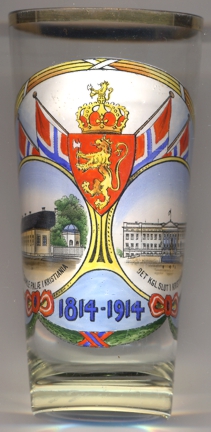
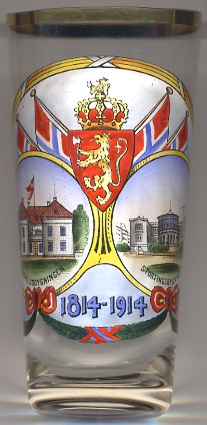 According to the Norse sagas, Oslo was founded around 1049 by King Harald Hardråde. Recent archaeological research
has uncovered Christian burials which can be dated to prior to AD 1000. The city was elevated to a bishopric in 1070
and a capital under King Haakon V (1299–1319) around 1300, the first king to reside permanently in the city.
A century later, Norway was the weaker part in a personal union with Denmark, and Oslo's role was reduced to that of
provincial administrative centre, with the monarchs residing in Copenhagen. The personal union
with Denmark lasted from 1397 until 1536 and again from 1536 until 1814. Oslo was destroyed several times by fire, and
after the fourteenth calamity, in 1624, King Christian IV of Denmark and Norway ordered it rebuilt at a new site
across the bay, near Akershus Castle and given the name Christiania. Long before this, Christiania had started to
establish its stature as a centre of commerce and culture in Norway. In 1814 Christiania once more became a real capital
when the union with Denmark was dissolved, but in the same year the personal union with Sweden was establised, which
lasted until 1905. In 1850, Christiania overtook Bergen and became the most populous city in the country. Following a
spelling reform in 1877, the city was renamed Kristiania. The original name of Oslo was restored in 1925.
[http://en.wikipedia.org/wiki/Oslo]
According to the Norse sagas, Oslo was founded around 1049 by King Harald Hardråde. Recent archaeological research
has uncovered Christian burials which can be dated to prior to AD 1000. The city was elevated to a bishopric in 1070
and a capital under King Haakon V (1299–1319) around 1300, the first king to reside permanently in the city.
A century later, Norway was the weaker part in a personal union with Denmark, and Oslo's role was reduced to that of
provincial administrative centre, with the monarchs residing in Copenhagen. The personal union
with Denmark lasted from 1397 until 1536 and again from 1536 until 1814. Oslo was destroyed several times by fire, and
after the fourteenth calamity, in 1624, King Christian IV of Denmark and Norway ordered it rebuilt at a new site
across the bay, near Akershus Castle and given the name Christiania. Long before this, Christiania had started to
establish its stature as a centre of commerce and culture in Norway. In 1814 Christiania once more became a real capital
when the union with Denmark was dissolved, but in the same year the personal union with Sweden was establised, which
lasted until 1905. In 1850, Christiania overtook Bergen and became the most populous city in the country. Following a
spelling reform in 1877, the city was renamed Kristiania. The original name of Oslo was restored in 1925.
[http://en.wikipedia.org/wiki/Oslo]
In 1814, in the brief period after the dissolution of the personal union with Denmark, a constitution for the country was
set up. Glasses no. 2869 and 2844 are commemortive souvenirs for the celebration of the 100th anniversary of the
constitution in 1915, showing views of Oslo [left, no. 2869: both pictures, and right, no. 2844:
right picture] and from Eidsvoll [right, no. 2844: left picture],
the place where the Norwegian constitution was drafted.
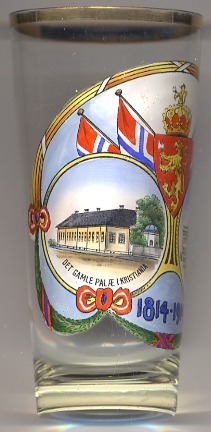 The
The  Old Palais (Gamle Palæ or Gamle Paléet in Norwegian
Bokmål and Nynorsk, respectively) [left, no. 2844: left picture] was originally built in
1744–1745 by the merchant and shipowner Christian Ancher. In 1805, Ancher's son, Bernt Anker, bequeathed the
building to he state. For a while the building was used by the Danish viceroys in Norway. From 1814 it became a royal
residence for the first king of independent Norway, King Christian Frederik. However, the king had to abdicate in the
same year in favour of Sweden and returned to Denmark where he acceded to the Danish throne in 1839 (Christian VIII).
As Norway was now united with Sweden in a personal union under Karl XIII, the palais remained a royal residence
until the Royal Palace of Oslo was completed in 1849. The palais was destroyed by fire on 14 May 1942.
[http://nn.wikipedia.org/wiki/Paléet]
Old Palais (Gamle Palæ or Gamle Paléet in Norwegian
Bokmål and Nynorsk, respectively) [left, no. 2844: left picture] was originally built in
1744–1745 by the merchant and shipowner Christian Ancher. In 1805, Ancher's son, Bernt Anker, bequeathed the
building to he state. For a while the building was used by the Danish viceroys in Norway. From 1814 it became a royal
residence for the first king of independent Norway, King Christian Frederik. However, the king had to abdicate in the
same year in favour of Sweden and returned to Denmark where he acceded to the Danish throne in 1839 (Christian VIII).
As Norway was now united with Sweden in a personal union under Karl XIII, the palais remained a royal residence
until the Royal Palace of Oslo was completed in 1849. The palais was destroyed by fire on 14 May 1942.
[http://nn.wikipedia.org/wiki/Paléet]
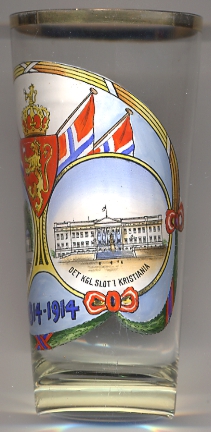 The
The  Royal Palace (Det kongelige slott or Det kongelige slottet)
[near left, no. 2844: right picture] was built in 1825–1849 by Hans Ditlev Franciscus Linstow.
The palace became the permanent residence of the Norwegian kings when the union of Norway with Sweden was dissolved in 1905
and Prince Carl of Denmark from the House of Schleswig-Holstein-Sonderburg-Glücksburg,
second son of Crown Prince Frederik of Denmark, was elected to become king of Norway and took the name Haakon VII.
During the reign and residence of King Olav V from 1957 to 1991, the Royal Palace was not renovated and insufficiently
kept up. When the current monarch, King Harald V, started a comprehensive renovation project, he was criticized due
to the amount of money needed to bring the Palace up to a satisfactory state. Since public tours began in 2002,
the general public has been able to view and appreciate the renovation and splendour that the palace now boasts.
[https://en.wikipedia.org/wiki/Royal_Palace,_Oslo]
Royal Palace (Det kongelige slott or Det kongelige slottet)
[near left, no. 2844: right picture] was built in 1825–1849 by Hans Ditlev Franciscus Linstow.
The palace became the permanent residence of the Norwegian kings when the union of Norway with Sweden was dissolved in 1905
and Prince Carl of Denmark from the House of Schleswig-Holstein-Sonderburg-Glücksburg,
second son of Crown Prince Frederik of Denmark, was elected to become king of Norway and took the name Haakon VII.
During the reign and residence of King Olav V from 1957 to 1991, the Royal Palace was not renovated and insufficiently
kept up. When the current monarch, King Harald V, started a comprehensive renovation project, he was criticized due
to the amount of money needed to bring the Palace up to a satisfactory state. Since public tours began in 2002,
the general public has been able to view and appreciate the renovation and splendour that the palace now boasts.
[https://en.wikipedia.org/wiki/Royal_Palace,_Oslo]
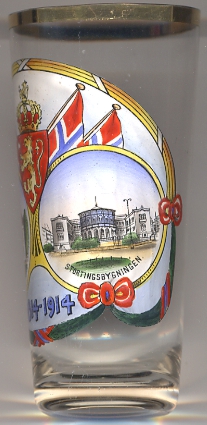 The
The  Stortingsbygningen [right, no. 2844: right picture]
is the seat of the Parliament of Norway, located in central Oslo.
Following the establishment of the Parliament of Norway in 1814, which had happened at Eidsvoll,
the newly established legislature started meeting at Christiania lærde Skole. From 1854, the legislature started using the
grand hall at the Royal Frederick University. However, proposals of an own parliament building had arisen. The parliament
voted down a government proposal to create such a building in 1833, but in 1836, the work to establish a permanent building
started. A design competition was initiated in 1856, and this was won by the architects Heinrich Ernst Schirmer and Wilhelm
von Hanno. However, parliament decided to reject the proposal because it looked “too much like a church”.
Instead, a proposal from the Swedish architect Emil Victor Langlet was chosen in 1860. Construction started in August 1860,
and the cornerstone was laid in October 1861. The parliament moved in on 5 March 1866. Initially, the building was too
large for the needs of the legislature, and several other government agencies, including the Office of the Auditor General
of Norway, the National Archival Services, the Mapping and Cadastre Authority and the Director of Canals were also housed
there. As the parliament has expanded, these various agencies have moved out. During the German occupation in World
War II, the building was taken over by the German forces, and at first used as barracks. Later, Reichskommissar
Josef Terboven with administration moved into the building. From 1951 to 1959, a four-story office building was built at
the back of the building.
[http://en.wikipedia.org/wiki/Parliament_of_Norway_Building]
Stortingsbygningen [right, no. 2844: right picture]
is the seat of the Parliament of Norway, located in central Oslo.
Following the establishment of the Parliament of Norway in 1814, which had happened at Eidsvoll,
the newly established legislature started meeting at Christiania lærde Skole. From 1854, the legislature started using the
grand hall at the Royal Frederick University. However, proposals of an own parliament building had arisen. The parliament
voted down a government proposal to create such a building in 1833, but in 1836, the work to establish a permanent building
started. A design competition was initiated in 1856, and this was won by the architects Heinrich Ernst Schirmer and Wilhelm
von Hanno. However, parliament decided to reject the proposal because it looked “too much like a church”.
Instead, a proposal from the Swedish architect Emil Victor Langlet was chosen in 1860. Construction started in August 1860,
and the cornerstone was laid in October 1861. The parliament moved in on 5 March 1866. Initially, the building was too
large for the needs of the legislature, and several other government agencies, including the Office of the Auditor General
of Norway, the National Archival Services, the Mapping and Cadastre Authority and the Director of Canals were also housed
there. As the parliament has expanded, these various agencies have moved out. During the German occupation in World
War II, the building was taken over by the German forces, and at first used as barracks. Later, Reichskommissar
Josef Terboven with administration moved into the building. From 1951 to 1959, a four-story office building was built at
the back of the building.
[http://en.wikipedia.org/wiki/Parliament_of_Norway_Building]
![[scale]](lineal.jpg)